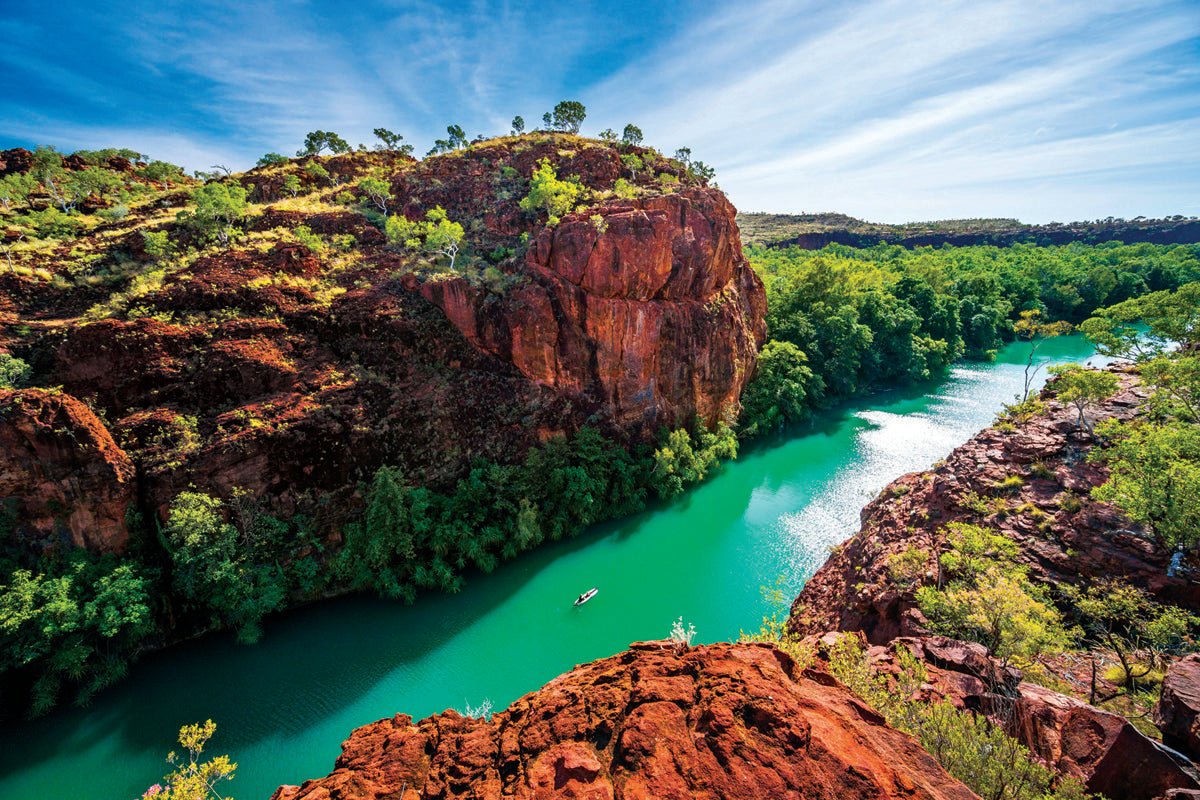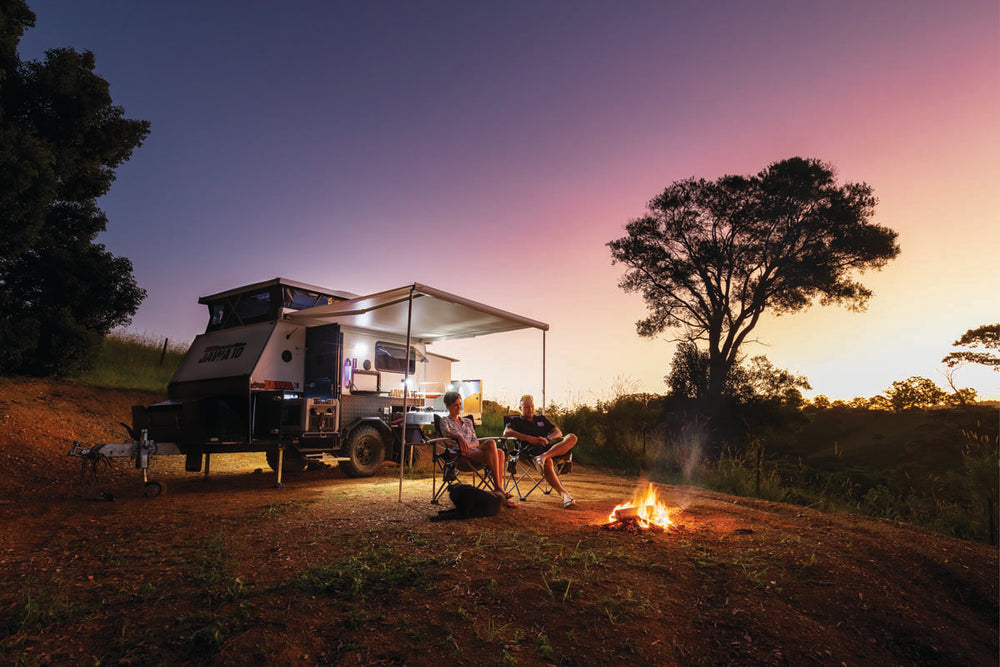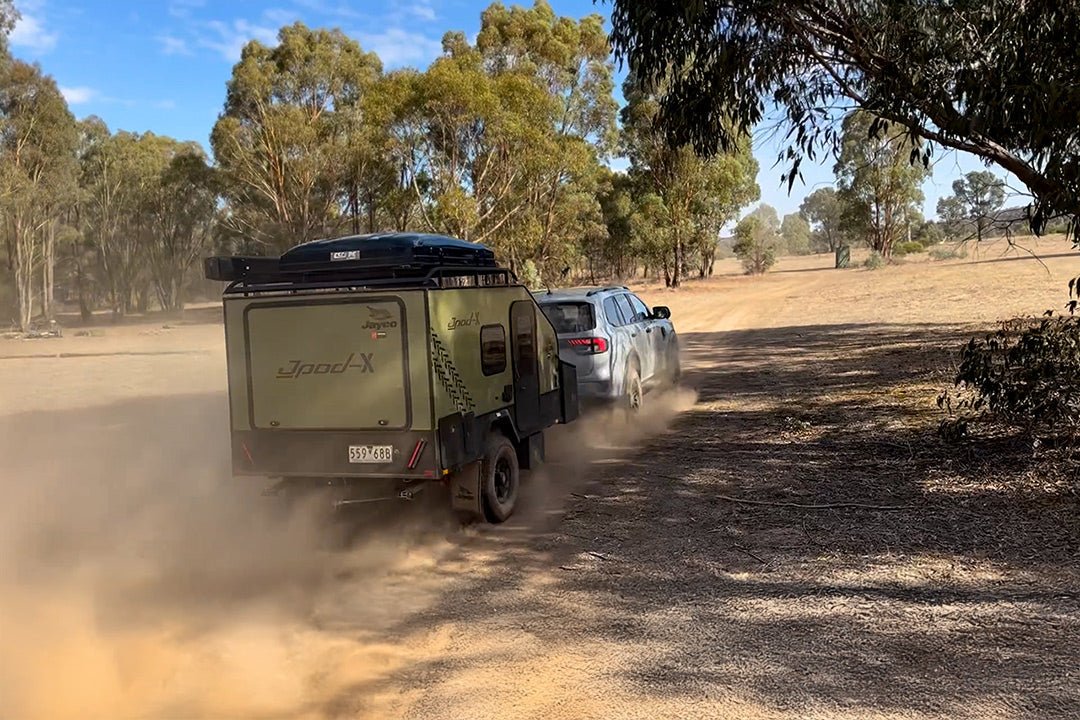Down by the Waterhole

Free camping has never looked this lovely out west, and that’s the reason caravanners arrive in droves, detouring far off the beaten track to park their rigs riverside and plonk camp chairs in the shallows.
If you’ve never heard of Gregory, it’s because this tiny Queensland town has a population count of around 70, and its pub is all that’s stopping it from turning ghostly.
But its namesake river, the Gregory — one of Queensland’s longest, ever-flowing waterways — draws a crowd. Every winter, self-sufficient caravanners stop by en route to Karumba and Lawn Hill Gorge and quickly find themselves waylaid by the Gregory.
Park your rig on the river’s wide, pebbly banks and fill long, lazy days swimming and reading at the water’s edge, watching wildlife as you paddle a kayak far upstream and ride the rapids back down again, drifting silently past the wallabies that hop on down for a drink.
Located 100km east of Boodjamulla National Park, the Gregory’s free camp makes an ideal staging post for paddling adventures on Lawn Hill Gorge, but you’ll have to tear yourself away from the Gregory River first.
HISTORY OF GREGORY DOWNS
Gregory wasn’t always a one-horse town. In the early 1900s, coaches pulled into Gregory Downs (as it was known until 2013) to rest for a while en route to Burketown, and a mounted police post kept things civilised.
The town serviced one of the first cattle runs in the Gulf Savannah, and though you won't notice it from the road, fortunes continue to be made on the grazing lands around Gregory. Way back then, Gregory Downs Station was named to honour the great explorer Augustus Gregory, leader of the 1885 North Australia Expedition.
Ambitious for its day, Gregory’s was the first full-scale land exploration of the romantically tagged 'Plains of Promise', a vast monsoonal savannah stretching from Gregory to the Leichhardt River. Gregory’s legacy extends far and wide, across the border to Timber Creek where an old boab known as the Gregory Tree remembers his exploits.
Today, racing and rodeos dominate Gregory’s social winter calendar, but it’s the watery action that takes place on the 321km-long Gregory River every May that causes the most fuss. Known as Australia’s most isolated paddling race, the Gregory River Canoe Marathon turns the usually quiet waterway into adventure central, as paddlers race 43km to the finish line behind the Gregory Downs Hotel.
Staged for the last 43 years, the race attracts around 150 paddlers and thousands of onlookers whose campsites crowd the riverbank and swell the sleepy town’s numbers for one wild weekend. The peace is restored a day later, so time your trip if you want to join the fun.
RELAXING RIVERSIDE
For the rest of the year, Gregory is a serene, shady spot where cockatoos screech from the paperbarks and travellers wallow in the shallows, swimming and chatting as they take a break from the road. The croc-free waterholes are irresistible: spring-fed, clear and cool, and fringed with stranger figs and towering Livistona Rigida palms.
If you’ve got kids (or kids-at-heart), give the river’s rope swing a workout, shooting downstream over the rapids and trotting back along the pebbly banks for ride after ride. You can paddle and follow tracks far up the river’s western bank, and join the campers nursing cold drinks and dangling feet in the Gregory’s cool, glassy flow at day’s end.
When it comes time to have a night off cooking, the Gregory Downs Hotel is just a short stroll away for chilly ales, meals and screen time. The hotel sells fuel, ice-creams and takeaway drinks too, and with no mobile reception anywhere in town, the pub is the only place where you can get a weather update.
Be warned: If you love your daily Facebook fix, a stay at Gregory will enforce a digital detox so book your next campsite at Boodjamulla National Park or Karumba before reaching town. Across from the pub there’s a kids' playground, toilets, a dump point, cold water showers and rubbish bins.
These are the facilities that the riverside camp lacks, and complaints about visitors’ wayward toileting practices is what led the Burke Shire Council to carve out a designated camping area with toilets on high ground above the river.
It’s rather lacking in shade, so most head to the breezy waterfront and, so far, the council hasn’t put a stop to it. The onus is on travellers to contain their waste (including greywater) or use the cold water showers opposite the pub to keep soap and shampoo out of the river.
If you arrive in Gregory early in May, keep an eye on the weather because late season rains can rapidly raise the river level without warning. I’ve heard frightening tales of midnight escapes when flooding rains swelled the riverbed, forcing caravanners to pack up in haste and inch their rigs up the camp’s slippery, unsealed access track in the pouring rain.
Once the wet season ends, Gregory is a standout destination and so much more than a free place to overnight. When you go, be sure to have a few days up your sleeve before you head off to your campsite at Boodjamulla National Park, 100km west.
BOODJAMULLA'S OASIS
On Queensland’s far western border, Lawn Hill Creek blazes an emerald, palm-fringed path to the sea, greening the parched landscape of sandstone ranges and spinifex plains. Traditional owners say that the rainbow serpent — the Boodjamulla — carved out the creek to nurture the freshwater crocodiles and flying foxes, wallaroos and barramundi that the Waanyi hunters depended on.
It’s a simply stunning destination and the national park campsites are a bargain, well located within easy walk of the water’s edge for your 6km-long canoe adventure deep into the gorge. You can climb high above Lawn Hill Creek for big-picture vistas, but there’s nothing like experiencing the gorge from the bow of a canoe, especially at first light when the rising sun ignites its towering, sandstone cliffs.
Bring your own canoe or kayak to get out on the water at first light and you’ll have this incredible savannah destination all to yourself. If you are travelling light, there’s a rental stand at the end of Duwadarri Waterhole where purple water lilies bloom, and Adels Grove does gorge cruises for $40/adult.
You’ll need two to three hours to paddle up Middle Gorge, past Indarri Falls’ delicate tufa dam that segregates Lawn Hill Creek into two long, deep waterholes, and beyond into Upper Gorge. Tie up your canoe and snorkel beneath Indarri Falls to spot the giant catfish, archerfish and snapping turtles that thrive in the clear, 30m-deep pool.
Continuing into Upper Gorge requires a short portage around the falls and is well worth your effort for the birdlife you’ll spot along this quieter stretch of water. At the far end near the rapids, you’ll undoubtedly attract the attention of spitting archerfish that spray jets of water to knock down insects, frequently launching themselves clean out of the creek to the surprise of paddlers whose fingers attract the odd nibble as well.
Ducks and darters prefer the less visited Upper Gorge, flying out from the fan palms and spinifex-covered slopes dotted with snappy gums and rocky outcrops.
Boodjamulla’s national park campsites are affordable and appealing, with easy-to-access swimming and just enough facilities. There are 20 individual sites, most suitable for caravans, and cold water showers, drinking water (boil first), toilets, picnic tables, an interpretive shelter and a ranger on site if you need one.
The swimming is sheer heaven and away from the water, the Wild Dog Dreaming trail leads to petroglyphs, shell middens and a lookout over Lawn Hill Creek where freshwater crocodiles bask in the sun (4.5km/1.5hrs return). If you like a good hike, I recommend climbing the Constance Range in time for sunset, setting out on the trail at around 4pm with a head torch packed for the return journey back to camp (three hours' return).
The park’s steepest climbs are best tackled on cool mornings, especially the stiff ascent to Duwadarri Lookout for 360-degree views over Middle Gorge and the surrounding escarpments (600m/30 minutes return). Island Stack elevates walkers too, providing panoramic views from its lofty tabletop formation (4km/two hours return).
WEIRD AUSSIE MEGA FAUNA
Boodjamulla’s boundaries also protect the excavation site of strange fossilised mega fauna at Riversleigh World Heritage Area, a 50km drive away. Free to enter and set up for self-guided exploring, Riversleigh’s D site is located right by the road and showcases just some of the 25 million-year-old prehistoric species that have been unearthed so far.
You’ll spot the rocky remains of a five metre-long freshwater crocodile, a giant Riversleigh turtle, and a flightless thunderbird nicknamed ‘Big Bird’ that reputedly stood around 2.5m tall and weighed 250-300kg. Wilder creatures have been unearthed too: meat-eating kangaroos, giant wombats, carnivorous lions and the almost complete skeleton of a thylacine.
There’s plenty of information on site and if you happen to be travelling with kids, consider the day’s homeschooling done. Riversleigh rates as Australia’s richest known mammal fossil deposit and is also one of the world’s most significant so don’t miss it.
A detour to Riversleigh is a great way to fill a morning, leaving plenty of time to swim and paddle back at Boodjamulla before sunset. If you heading south from Lawn Hill to Mt Isa and the Barkley Highway, you’ll pass right by Riversleigh and Miyumba Bush Camp, located just opposite on the Gregory River.
Reaching far-flung Boodjamulla from any direction is no easy feat, so if you need a few creature comforts when you arrive, there are hot showers, restaurant meals and ice creams on offer at nearby Adels Grove (along with fuel and basic supplies too).
GETTING THERE
Gregory is located 420km south of Karumba on the Wills Developmental Road. Continue 100km west to Boodjamulla National Park. The 330km-long drive from Boodjamulla to Mt Isa (via Riversleigh WHA) is best suited to off-road vehicles and rigs as there are river crossings to tackle just after the wet season. For road reports visit racq.com.au.
Where to stay: In Gregory, a free camping area by the bridge provides toilets, but most travellers camp down on the riverbed (no facilities). The pub sells fuel, takeaway drinks and meals (no mobile reception), and opposite there are toilets, a dump point, cold water showers, rubbish bins and a playground. Book your campsite in Boodjamulla well in advance for peak season stays ($6.65 per person, $26.60/family, visit qpws.usedirect.com/qpws). There are no park entry fees. Facilities include water (boil first), toilets, coldwater showers, picnic tables and a park interpretive shelter (no pets, campfires, generators, fishing or motorised boats allowed). At Adels Grove, unpowered campsites cost $20/adult, $10/child and $55/family (adelsgrove.com.au).
What to pack: BYO a kayak or rent a canoe on site (allow 2-3 hours): $27.50/hour (2-person canoe) or $35/hour (three-person canoe).
When to visit: Cool, dry conditions make winter an ideal time to visit (May to August). Wet season rains frequently close access to this region from December to March, and the Gregory River may flood as late as May.
Don't miss: Riversleigh World Heritage Area to discover fossilised Aussie mega fauna (100km return drive from Lawn Hill Creek). The 43km-long Gregory River Canoe Marathon takes place in May (northwestcanoeclub.org.au).







